President Harry Truman visited George Marshall at his homes in Leesburg, Virginia, and Pinehurst, North Carolina, six times. A search of Truman’s daily appointment calendar on the Truman Library website provided information about four of the visits. Records also suggest that Truman sometimes drove his presidential car on those trips.
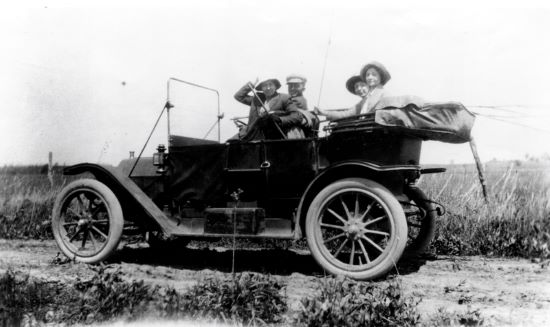
Harry Truman loved to drive. Shown here in 1915, with Bess Wallace (later Bess Truman) holding her hat. Photo courtesy Truman Library.
The first calendar entry, August 13, 1948, said, “The President left by car with General George C. Marshall for Leesburg, Virginia, stopping at the Balls Bluff Civil War Battlefield. The President dined with General and Mrs. Marshall at their Leesburg home. He returned to Washington by motor going direct to the Navy Yard where he boarded the USS WILLIAMSBURG [presidential yacht] for cruise.”
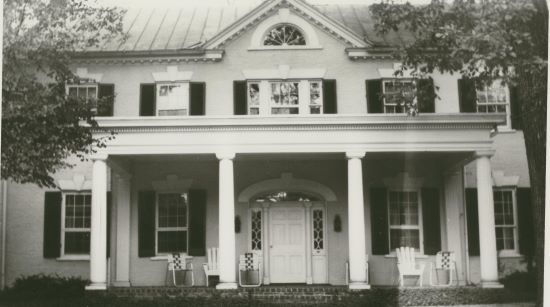
George and Katherine Marshall’s home in Leesburg, VA.
A year later, Drew Pearson mentioned that visit to Balls Bluff in his nationally syndicated newspaper column. According to Pearson, Marshall had told Truman that Oregon senator Edward Baker had been killed in a Civil War battle at Balls Bluff, near Leesburg, in 1861 – the only senator killed in battle – and had been buried on the battlefield. Truman asked Senator Wayne Morse of Oregon to accompany him on a trip to Leesburg to see Baker’s grave. Pearson said that Truman was driving the presidential Lincoln limousine and that Morse had asked him about the last time that he had driven. The president said it had been a couple of years but that he still remembered how. According to Pearson, however, “It was evident that whatever the president lacked in skill as a chauffeur, he made up for in zestful driving. With the Secret Service men sitting nervously in the rear, the president enjoyed every minute of it.”
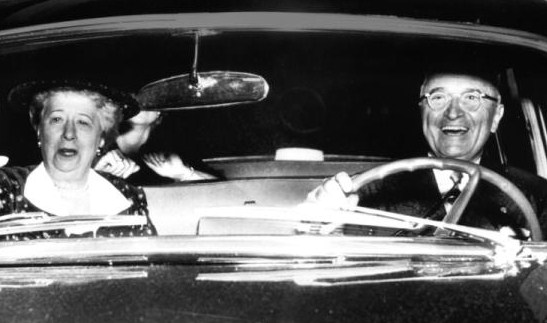
President Truman driving, with his wife Bess, giving directions. Photo courtesy J. Mark Powell.
Morse had learned before the visit, however, that Baker’s body had been taken to San Francisco for burial, and he informed Truman about Marshall’s mistake while they were driving to Leesburg. Pearson said that “the presidential car nearly swerved off the road.” “Poor General Marshall,” Truman responded to Morse, “we mustn’t hurt his feelings. You leave this to me.” At the battlefield, Marshall apologized profusely for his error, but Truman and Morse told him that they appreciated the chance to get away from Washington.
However, a Truman calendar entry for July 10, 1949, shows another date for a Morse visit: “The President left Blair House by motor with Senator Wayne Morse of Oregon. Drove to Leesburg, Virginia, where they visited General George C. Marshall at his home. The President and Senator Morse left Leesburg at 2:10 p.m. and returned to Washington, arriving at Blair House at 3:10 p.m.”
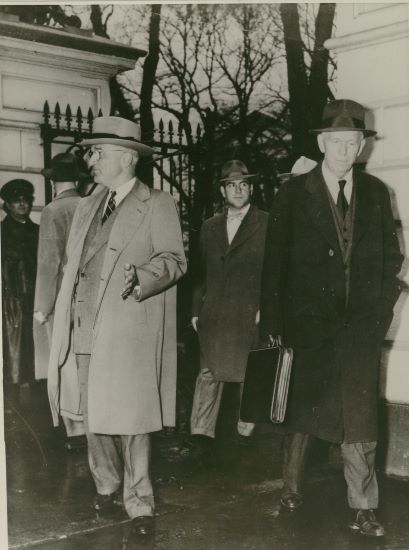
Sometimes George Marshall visited President Truman, too. Shown at Blair House, Truman’s residence while the White House was undergoing work.
An entry for another Leesburg visit on July 24, 1951, adds credence to Pearson’s claim that Truman occasionally took the wheel of the presidential car, albeit in an “off the record” note: “In the afternoon the President went for a drive, accompanied by the Chief Justice and Mrs. Fred Vinson, and stopped at the Leesburg home of the Secretary of Defense and Mrs. George C. Marshall. They remained for an informal supper, after which they motored back to the Blair House, the President himself taking the wheel on the return trip.”
On May 9, 1952, Truman wrote Marshall that he and his daughter Margaret had planned to drive to Leesburg on the previous Sunday, May 4, but decided against it because of Clifton Brown’s illness. [Clifton, Marshall’s stepson, died May 11.] Marshall replied to Truman on May 21, saying that Clifton’s death and Marshall’s own bout with the flu had “left many things undone.” Truman responded on May 26, saying that he and his daughter wanted to “organize a Sunday morning drive” to Leesburg to see the Marshalls. Marshall replied on May 29 and invited the Trumans to come for lunch on Sunday, June 1. Truman did not get the note until June 1 and did not make the trip.
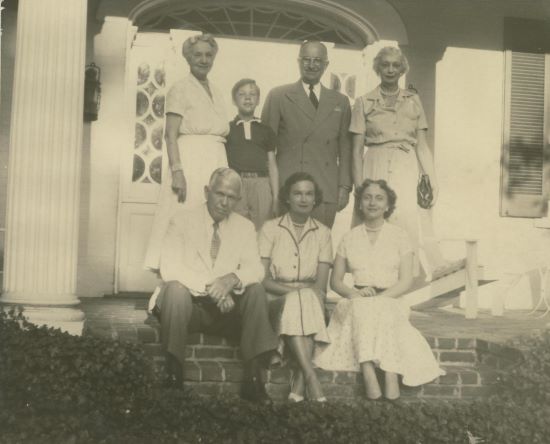
Visit of President Truman and his daughter Margaret to the Marshalls. Shown L to R back: Katherine, Tupper Brown (grandson), President Truman, Helen Bolling Lee. L to R front: Marshall, Mary Lee, Margaret Truman.
He did go to Leesburg on June 8. According to the record, “The President motored to General Marshall’s home in Leesburg, Virginia, and remained for the afternoon. In the evening the President went to the Union Station to see Miss Margaret off for New York.” In her book about her father, Margaret Truman wrote: “Among my fondest memories are the Sunday visits that we made to the General and Mrs. Marshall, in their lovely house in Leesburg, Virginia.” She also shed light on the driving: “I usually did the driving. Dad was inclined to drive with his mind on affairs of state.”
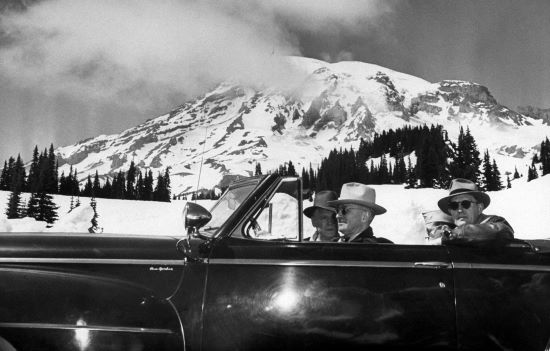
President Truman driving by Mount Rainier in Washington State. Photo courtesy Michael Beschloss via Twitter (@BeschlossDC).
That list of visits to Leesburg does not include July 4, 1950, when Truman went to Leesburg to ask Marshall to become Secretary of Defense. Truman later thanked Marshall for his hospitality that day and remarked about the trip: “Margaret had a wonderful time and enjoyed the trip. Our drive both ways was pleasant and not in any way obstructed by the holiday traffic. Later in the day, I have been told, the road was blocked for twenty miles.”
Truman also visited the Marshalls’ winter home in Pinehurst on January 12, 1950, when Marshall was recuperating from lung surgery. Truman’s press secretary, Charlie Ross, said that Marshall was “absolutely flabbergasted” when the president walked into his bedroom, causing Marshall to exclaim, “My goodness! Where did you come from?” Truman probably broached the subject of Marshall’s taking the presidency of the American Red Cross.
Tom Bowers is the former docent director at George Marshall’s Dodona Manor in Leesburg, Virginia. He was professor and dean of the School of Journalism and Mass Communication at the University of North Carolina at Chapel Hill from 1971 to 2006.
